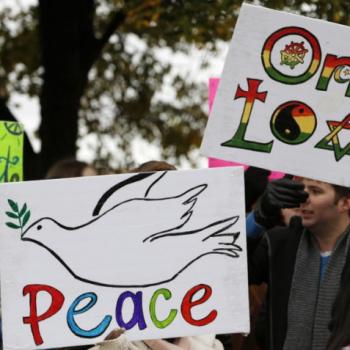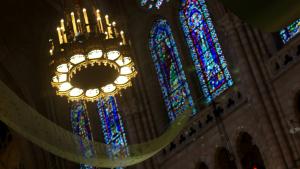Why do people come to church?
Regular readers of this blog will know that I think about this topic quite often.
Apparently, other people do, too. Or at least they think about it sometimes.
In her recent Washington Post Magazine article “Church Junkie,” V.C. Chickering recounts her own adventure of finding a community of faith. She describes a personal crisis that led her to look for “people who would be nice to me for less than $125 an hour.”
I hate to even include that phrase (even though I thought it was funny), as I am fairly certain our church administrator might take offense (he thinks we should sell tickets for a lot more than that. Just kidding! Kind of.). And, I cringe a little as I read it, because (don’t be shocked) sometimes people at church are not nice to each other.
That being said, I can think of many (myself included) who have embarked on a journey to find “what they are looking for,” only to discover it in a large building with slippery pews and stained glass windows.
Strangely enough, I wrote about just this thing in our May church newsletter (though, sadly, my take was not nearly as funny as Chickering’s, due in large part to the fact that our church newsletter editor is quite pushy about deadlines. That and the small detail that I don’t often write for the Post. Actually, I never write for the Post.).
Nevertheless, I share my thoughts here:
There’s been quite a lot of talk in this town lately about newcomers to our city shopping for a church home.
As this is always an interest of mine, I thought I might share some thoughts about what qualities one should be looking for in a healthy community of faith, and what I hope anyone might find if they came to visit Calvary.
Church Shopping Checklist
(or, some qualities of a healthy faith community)
Excellent Worship. How do we plan and lead worship where people actually worship God? This is the question on everyone’s mind as the church becomes less and less of a cultural requirement and more and more of a lifestyle option. Some churches have adopted the view that high-tech bells and whistles or splashy programming is the way to go.
But what about faith communities with limited resources (material, emotional or otherwise)?
The bottom line is that meaningful worship should first and foremost be genuine worship. In other words, whatever you do, make sure you do it well.
To assess, we can ask ourselves: have we given intentional thought and careful planning to the order of worship; the leaders in worship; the music and other elements in worship? Are we trying to do something in worship that we are not prepared to do, or that doesn’t reflect the values of our community? If so, our worship will come across as inauthentic and poorly planned. It doesn’t take fancy accoutrement to draw people in; it does take excellence and intentionality.
Friendly Welcome. Some people say they like to be anonymous when they go to church but overall I don’t buy it. There’s nothing that sends a message more loudly than a worshipping community that does not express a warm welcome to visitors. People want to be noticed and welcomed! Communities that make it easy to feel comfortable are communities that know who they are and are expressing their identity in healthy ways. A warm welcome to folks who are new is a good indication that this is a place I’d like to explore a little more.
Clean, Easy to Navigate Facility. Studies show that the #1 reason people do not come to visit a church more than once is . . . dirty bathrooms. This is not a lie. How we keep our facilities, and how comfortable people feel navigating our church building are important factors for visitors.
Clear Vision and Identity. When you walk into a place of worship can you easily discern the community’s vision and identity? This should be accessible to a visitor ahead of time on the website or in any publicity a potential visitor seeks out. When you get to church you should also be able to identify vision and identity through printed material, like the bulletin and available information for visitors.
The real test, however, happens experientially. If a community defines a vision and identity that is not readily apparent experientially, it’s time to start asking questions. For example, if a church advertises its ministries to children but there is no sign of anyone under age 50 in worship, a visitor should begin to ask if this community really knows who it is and whom it serves.
Easy Ways to Reengage. Church should never be a “one-shot” deal. That’s a practical standard and also a theological standard. Practically, a church visitor should easily be able to access opportunities to engage beyond Sunday worship-he or she should be invited to an event, offered the opportunity to respond by filling out a card, or even just read about some upcoming program that sounds interesting. An effective faith community uses every opportunity to invite folks to engage; this is how we each find our individual expressions of God’s call within the larger community.
Theologically, church should never be a one-hour-per-week exercise. What we do and hear and experience on Sunday morning should inform and affect our lives for the rest of the week. Do you hear or experience something on Sunday morning that relates to your life the rest of the week? Vibrant faith communities help make these connections all the time.
Encounter With God. We pray an invocation prayer every Sunday, and not just because it’s part of the order of worship. Part of our practice every week is inviting God to be with us. One important factor to note when visiting a church is just that: is the community actively inviting and expecting God’s presence? Is there some way-through music, silence, liturgy, sermon, interaction with others-that I encountered God in this place?
Healthy and vibrant communities of faith gather each week in anticipation of God’s presence . . . of course the presence of God cannot be manufactured. But we can create space and time in which, individually and corporately, we can open ourselves to God. And this discipline of opening ourselves to God is a critical spiritual practice for any healthy community of faith.
Are our visitors finding these critical experiences when they come to visit us? It’s always good every once in awhile to check in and assess, and then give some intentional thought to how we might reflect these qualities even more effectively than we already do.
And . . . for the areas in which we’re lacking, the good news is that we don’t have to manufacture these qualities artificially; they naturally evolve out of healthy community and faithful practice.











